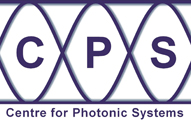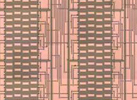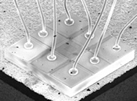| Centre for Photonic Systems Engineering Department Electrical Engineering Division |
 |
 |
 |
 |
 |
| Home | Research | People | Publications | Teaching | CDT | News | Contact |
|---|
|
CURRENT PROJECTS
PREVIOUS PROJECTS |
Blue Femtosecond Laser Implemented with Group-III Nitrides: Femtoblue Objectives: The overall target of the FemtoBlue project is an ultrafast semiconductor laser diode that is capable of producing femtosecond optical pulses in the blue and violet spectral range. Such a miniature femtosecond laser is a photonic component that can meet the requirements of various ICT based/related applications including biomedical diagnostic equipment, optical combs, synchronization (time/frequency transfer) and entangled photon pairs generation for quantum communications. This is a broad spectrum of applications that is not addressable by semiconductor picosecond gain-switched lasers and which requires bulky laboratory installations with solid-state mode-locked lasers (eg a Ti:Sapphire laser with a second harmonic generator). The driving concept of FemtoBlue objectives and its targeted practical outcome is a femtosecond laser diode in the violet-blue optical spectrum that will enable lower cost and portable implementations addressing the existing and new applications requiring or benefiting from femtosecond optical pulses. The concept of a blue femtosecond semiconductor laser diode (FemtoBlue) is inspired by the growing impact of emerging device technologies based on GaN/InGaN alloys combined with the proven approaches to generate ultrashort optical pulses in the near-infrared spectral range that have been developed for conventional GaAlAs and InGaAsP alloy systems used in optical communications. A perfect match between the optical emission spectrum of wide-bandgap nitride alloys and the absorption spectrum in a majority of organic components indicates that the main application field for such ultrafast GaN/InGaN lasers and hence their possible major impact is related to bio-sensing technologies and medical applications, such as autofluorescence diagnostic (eg in endoscopy). The research has received funding from the European Community's Seventh Framework Programme (FP7/2007-2013, Future and Emerging Technologies - FET) under grant agreement no 238556. The following institutions form the Consortium Centre Suisse d'Electronique et de Microtechnique SA (CSEM) - Project coordinator Ecole Polytechnique Federale de Lausanne (EPFL) Fraunhofer Institute for Applied Solid State Physics (IAF) Cambridge University (UCAM) PN Lebedev Physical Institute (LPI) Technische Universitat Berlin (TUB) For further information visit http://femtoblue.epfl.ch/ |
2020 Centre for Photonic Systems: information provided by webmaster@cps.cam.ac.uk |